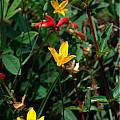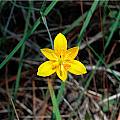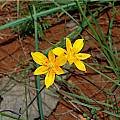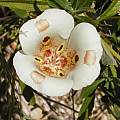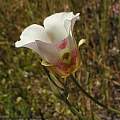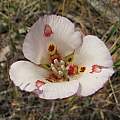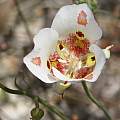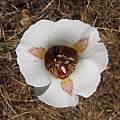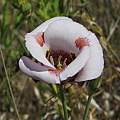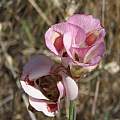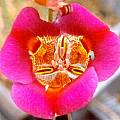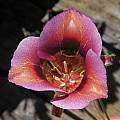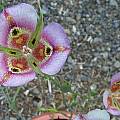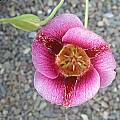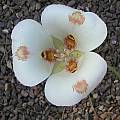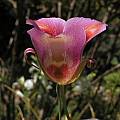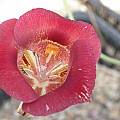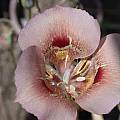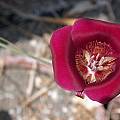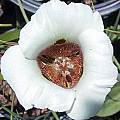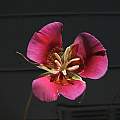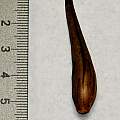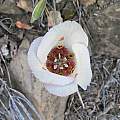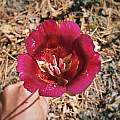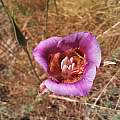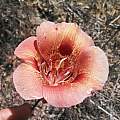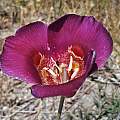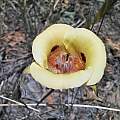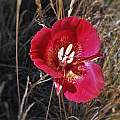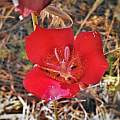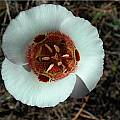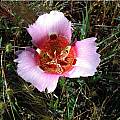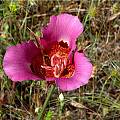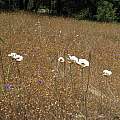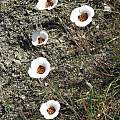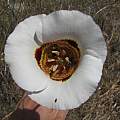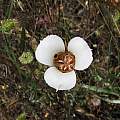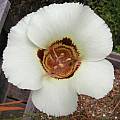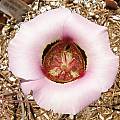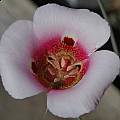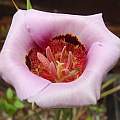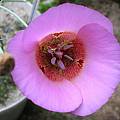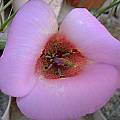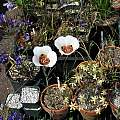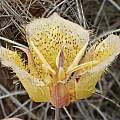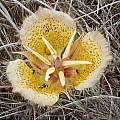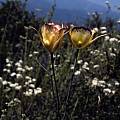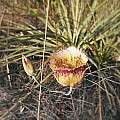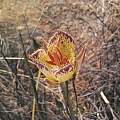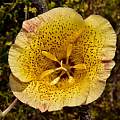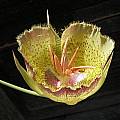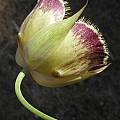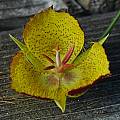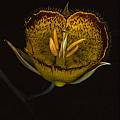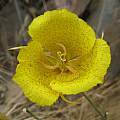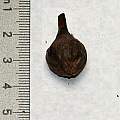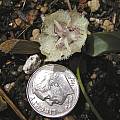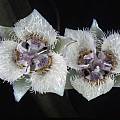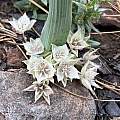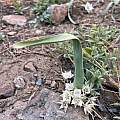Calochortus is a genus in the Liliaceae family with species distributed in western North America, Mexico, and south to Guatemala. The greatest concentration of species is found in California. Three good sources of information are Frank Callahan, The Genus Calochortus, in McGary, 2001 found listed in References, Calochortus, Gerritsen and Parsons, 2007 found listed in References, and Mariposa, the newsletter of the Calochortus Society, a quarterly issued between 1989 and 2005. Calochortus species v through the end of the alphabet are found on this page.
Calochortus species a-b - Calochortus species c-d - Calochortus species e-lo - Calochortus species lu-n - Calochortus species o-r - Calochortus species s - Calochortus species t-u - Calochortus hybrids - Calochortus index
Calochortus venustulus Greene, also known as the "Bearded Cyclobothra", is a wholly Mexican species, section Cyclobothra, subsection Ghiesbreghtiani. This is a fairly abundant species where found, and has erect 10-50 cm erect, glaucous, non-bulbiferous stems that bear 2-5 upright, shallow, campanulate to almost flat flowers. The range extends from northern Chihuahua to the Federal District, at elevations of 500-3500 m. This species was featured in Mariposa,Volume 3,#4. Photo by Mary Gerritsen.
Calochortus venustus Douglas ex Benth., the most variable Calochortus species in terms of color, is found in both the California coast ranges and the Sierra Nevada. It is found in open grassland and in mountain meadows at elevations ranging from sea level to 8,000 feet (2600 m). Color ranges from various shades of red to white, yellow, orange, and purple. The petals are often blotched midway, with another paler blotch on top. The nectary is more or less square and densely covered with angled hairs. This species was featured in Mariposa,Volume 2,#3. Because C. venustus has a very broad range, it's hard to generalize about how to grow it. The seeds of high-altitude varieties will require cold stratification in order to sprout (the most colorful forms generally grow at higher altitudes) and may be adapted to grow after the snow melts in spring. Low-altitude varieties may need protection from heavy frosts, and are likely to grow in winter. Height range: 1-2 ft. All forms need to be kept dry after they go dormant until the rains start in fall (usually October-November). There are some very nice color forms shown in the CalPhotos database here.
Photo 1-3 was taken by Mary Sue Ittner in Pinnacles National Park, CA, April 2005 where it was growing on a bank next to the road. Photos 4-5 were taken in the same location. Photo 6 was taken in Tuolumne Co. Photos 2-4 from Nhu Nguyen.
These photos were taken by Nhu Nguyen on Mount Diablo, CA.
The photos below by Mary Sue Ittner are of garden grown plants, showing color variation of this species.
These photos show more color forms. Photos 1-3 were taken by Jane McGary and show plants grown from seed provided in 1991 by the Robinetts and in 1999 by Ron Ratko, flowering in bulb frames in northwestern Oregon. Photo 4 is an almost white form with a single splotch purchased from the East Bay Regional Parks Botanic Garden and photographed by Max Withers. Photos 5-6 were taken by Nhu Nguyen of bulb/plant from Telos Rare Bulbs which was called "var. sanguineus".
Excerpts and photos from Kipp McMichael's "Calochortus pursuits":
"On a Sunday drive southeast of the Bay Area, I happened to have my first encounter of the season with Calochortus venustus. This plant was 2 feet tall and growing on the sunny, boulder-strewn slope of a roadcut. I would encounter this taxon again and again throughout the season."
"The next destination in my season of Calochortus pursuits was a very special population of Calochortus venustus in the central Sierra foothills. On drives in the foothills from Copperopolis to Camp Nelson, you can find mostly white C. venustus populations intermixed with variant individuals of deeper pink, red and fuchsia tones. The rarest of these color variants have brilliant petals fully painted inside and out with deep shades from magenta to rust. These flowers were some of the highlights of my season."
"My final Calochortus trip of the season was another overnight road trip returning to Mt. Pinos and the hills north of Santa Barbara. We returned to Mt. Pinos for the beautiful, bright red variant of Calochortus venustus that grows near the base of the mountain. Unlike some of the freely-blooming populations of Calochortus we had seen despite the drought, the red C. venustus were severely affected. We were able to find perhaps 10 plants in an area where thousands of bulbs could be seen in years past. The flowers we did find were beautiful, however."
Calochortus vestae (Purdy) Wallace is a large flowered, North Coast (California) range species with a common name of the Goddess Mariposa. This species increases by bulbils and likes a lot of water when in growth. It usually has a rust-colored gland that is shaped like a rounded inverted "w" (termed double lunate in some descriptions.) Flower color ranges from creamy white to lavender, pink, and even a few purple and magenta flowers in some populations. It grows in grassy meadows in heavy clay soils in full sun and in higher rainfall areas in serpentine. Height range: 30-50 cm. This species was featured in Mariposa,Volume 10,#1
The photos below by Mary Gerritsen were taken in late June, 2007 in the hills near Alderpoint, California.
The photos below were taken by Nhu Nguyen in Sonoma Co., CA.
The photos below are of plants in cultivation. Photos 1-2 were taken by Bob Rutemoeller of a white version and a pink one that fades to white over time. Photo 3-4 were taken by Mary Sue Ittner different years. Photos 5-6 were taken by Alan Horstmann.
Photos 1-2 were taken by Nhu Nguyen of a white form. Photo 1 shows it blooming along with Triteleia laxa and Bloomeria humilis.
Calochortus weedii Alph.Wood is from southern California (San Diego and Riverside Counties). It grows from sea level to the mountains, in chaparral often growing through shrubs to reach the sun. This species was featured in Mariposa,Volume 7,#2. It has yellow-orange petals flecked reddish brown and is densely hairy with fringed petal margins. Height range: 1-3 ft. Some members report that this species is difficult to keep going in cultivation, but Michael Mace reports that he has maintained it for more than a decade in pots in San Jose, CA, where it blooms in late May. His approach: Use a very well-drained mix (his is 50-50 coarse sand and peat, with a tablespoon of complete inorganic fertilizer), keep the pots completely dry in summer, give them full sun, and use the deepest pot you can find. An 8-inch (20 cm) pot is the minimum, and bigger is better. Protect from snails. When happy, these bulbs are vigorous. They will divide every year and dive deeper in the pot, so they need to be repotted at least every two years. The offsets will make up for the inevitable death of individual bulbs from time to time. Keep in mind that this species grows in near-desert conditions in the wild. The large and showy flowers are worth a bit of extra effort.
Calochortus weedii var. intermedius Ownbey, so called because its flowers appear intermediate between Calochortus weedii var. weedii and Calochortus plummerae is a rare taxon, found in Orange County, California, at elevations from sea level up to 700 m. It usually blooms in June to early July. The first two photos from Calflora were taken by Ron Vanderhoff in Orange County May 2022 and shared under a CC BY-NC license. The last photo below by Ron Parsons is from a wild population in Orange County.
Excerpts and photos from Kipp McMichael's "Calochortus pursuits":
"We hiked back to the car and headed for Casper's Wilderness Park near San Juan Capistrano. Our hike in Casper's started with another colony of all-but-done Calochortus davidsonianus. As we reached the ridgetop on the east side of the park, we started seeing a few struggling Calochortus weedii var intermedius. Another 1/2 mile of hiking brought us to a much better stand with robust blooms on stems over 2 feet tall. These plants were in fairly dense chaparral on a sandy ridge top growing near Yucca whipplei - a near constant companion of Calochortus species in Southern California."
Calochortus weedii var. peninsularis Ownbey is distributed in Mexico (peninsular ranges of Baja California del Norte). The flowers are yellow and the petals lack fringes. Photos from iNaturalist were taken by Jeff Bisbee in May near Ensenada, Mexico and shared under a CC BY-NC license.
Calochortus weedii var. vestus Purdy see Calochortus fimbriatus.
Calochortus weedii var. weedii bulb from Telos Rare Bulbs finally bloomed the 3rd year after it was purchased (July 2003) and although this species is reported to have two to six flowers, there was only one. But it was very beautiful. The first two photos shown below taken by Bob Rutemoeller show the flowers from the front and the back. After these pictures were added to the wiki there were no further flowers in 2004 or 2005. However it flowered again in July 2006 and this time there were two flowers. Mary Sue Ittner took the third photo of these flowers. The fourth photo below photographed by Ron Parsons is from a wild population in Monterey County, California. The fifth photo from San Diego County was taken by Jim Duggan. The last photo of a bulb was taken by Nhu Nguyen.
Calochortus westonii Eastw. is a plant of the southern Sierra Nevada. It has small flowers on short stems, but the tiny flowers are very pretty. I was able to grow it from seed and get it to flower once in coastal Northern California in spite of the fact that it naturally spends the winter under snow. It probably needs to be chilled every year for the best performance. Height range: 15-20 cm. Photo by Bob Rutemoeller. The second photo by Ron Parsons is of a wild population found in Kern County, California. The last two photos from Calflora were taken by Dee Shea Himes May 2022 in Kern County and shared under a CC BY-NC license.
Photos from iNaturalist were taken by Jacob Smith in May in Tulare County and shared under a CC BY-NC-ND license and by Ryan Donnelly in June in Tulare County and shared under CC BY license.
Calochortus species a-b - Calochortus species c-d - Calochortus species e-lo - Calochortus species lu-n - Calochortus species o-r - Calochortus species s - Calochortus species t-u - Calochortus hybrids - Calochortus hybrids - Calochortus index
